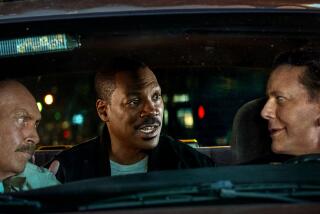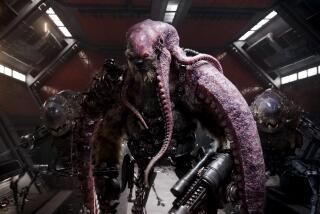MOVIE REVIEW : Mechanical ‘RoboCop 3’ in Need of Policing
- Share via
There’s probably sufficient energy and violence in “RoboCop 3” (citywide) to satisfy undemanding action fans, but it’s as mechanical as its cyborg hero. RoboCop is headed for a TV series, but this by-the-numbers third installment makes us feel we’re already there.
As many will recall, the “RoboCop” films project a time in the near-future when trouble-plagued Detroit’s police department will be run by a corporation, Omni Consumer Products, which in turn salvaged the face and brain of a mortally wounded cop, Alex J. Murphy, and placed them in a robot to create a kind of ultimate law enforcement weapon.
For the record:
12:00 a.m. Nov. 6, 1993 For the Record
Los Angeles Times Saturday November 6, 1993 Home Edition Calendar Part F Page 12 Column 2 Entertainment Desk 1 inches; 28 words Type of Material: Correction
New movies--The review of “RoboCop 3,” which also appeared Friday, referred incorrectly to the title of the adult comic book by Frank Miller; the correct title is “Batman: The Dark Knight Returns.”
Alas, Omni proved to be a corrupt and greedy outfit, which in the second film tried to finish off the principled and independent-thinking RoboCop with another robot. Now Omni, in cahoots with a Japanese conglomerate, is intent on brutally driving out the residents and merchants of an inner-city neighborhood to create a pricey Utopian oasis, Delta City. To that end a police doctor-scientist (Jill Hennessy) has been ordered to erase RoboCop’s memories so that he will become an easily controlled killing machine, but it’s hardly surprising that doctor and patient instead cast their lot with the small number of people resisting displacement.
It may be significant that this film and “RoboCop 2” were co-written by Frank Miller, celebrated creator of such adult comic books as “Sin City” and “Batman: The Dark City Returns.” That’s because “RoboCop 2” and “3” play as if they were written without any realization that there’s a difference between writing for a comic book and for the screen. Most films with a comic-book sensibility--or origins--wisely acknowledge their inspiration with a tongue-in-cheek approach, but “RoboCop 2” and “3” are played straight, which shows just how cardboard their characters are.
Therefore, “RoboCop 3,” under co-writer Fred Dekker’s uninspired direction, swiftly becomes a barrage of elaborately staged car chases and bloody battles occasionally interrupted by melodramatic exchanges in which the cast punches out its dialogue rather than speaks it. As a result, “RoboCop 3” is wearying rather than exciting.
Filmed largely in Atlanta rather than Detroit, “RoboCop 3” (rated PG-13 for violence, language) does not stint on production design (by Hilda Stark), which indeed is the film’s most imaginative aspect; in fact, there’s more life in the film’s colorful backdrop than in what’s happening in the foreground. Robert John Burke replaces Peter Weller as the original RoboCop, but so effective is his makeup you’d never guess it wasn’t Weller if you didn’t know. Nancy Allen returns as feisty cop Anne Lewis, as do Robert DoQui as the apoplectic Sgt. Reed and Felton Perry as OCP’s obsequious PR man. The standouts, however, are the always formidable CCH Pounder as the leader of the resistance, Rip Torn as OCP’s unctuous new CEO and Mako as a tough-minded Japanese tycoon.
‘RoboCop 3’
Robert John Burke: RoboCop Nancy Allen: Anne Lewis Rip Torn: The CEO John Castle: McDaggett
An Orion Pictures presentation. Director Fred Dekker. Producer Patrick Crowley. Co-producer Jane Bartelme. Screenplay by Frank Miller, Dekker; from a story by Miller based on characters created by Edward Neumeier & Michael Miner. Cinematographer Gary B. Kibbe. Editor Bert Lovitt. Costumes Ha Nguyen. Music Basil Pouledouris. Production design Hilda Stark. Art director Cate Bangs. Set decorator Robert J. Franco. Sound Kirk Francis. Running time: 1 hour, 44 minutes.
MPAA-rated PG--13 (for violence, some language).
More to Read
Only good movies
Get the Indie Focus newsletter, Mark Olsen's weekly guide to the world of cinema.
You may occasionally receive promotional content from the Los Angeles Times.










